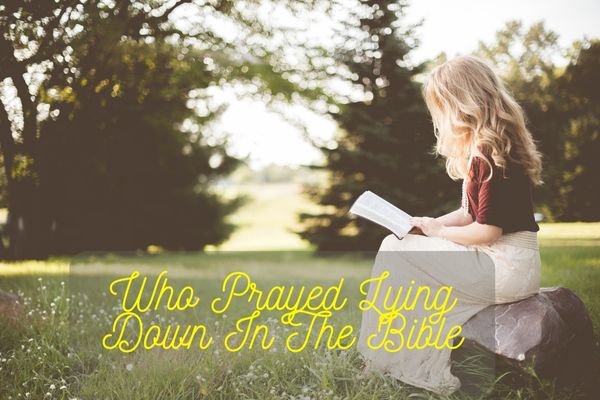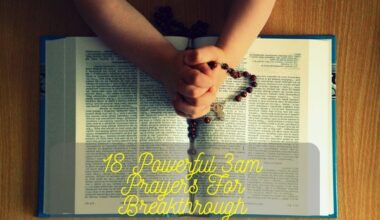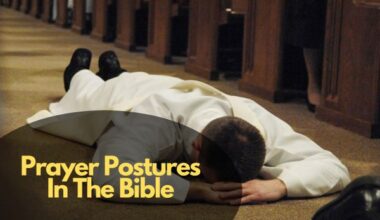In the Bible, the act of praying lying down is notably associated with King David. Found in Psalm 63:1, David’s poetic expressions reveal his intimate connection with the divine even in the solitude of the wilderness.
His profound communion with God reflected in lying down, showcases a unique posture of vulnerability and trust. This unconventional approach challenges traditional prayer stances, highlighting the diverse ways individuals engage in spiritual dialogue. David’s example serves as a reminder that the posture of the body matters less than the sincerity of the heart in the sacred act of prayer, offering a nuanced perspective on the varied expressions of devotion in biblical narratives.
Who Prayed Lying Down In The Bible?
In the Bible, there is a specific reference to a man named King David praying while lying down. This is mentioned in the book of Psalms, which is a collection of songs and poems attributed to David. In Psalm 63:1, David expresses his longing for God and his desire for a close relationship with Him. The verse says:
“O God, you are my God; earnestly I seek you;
my soul thirsts for you;
my flesh faints for you,
as in a dry and weary land where there is no water.”
While the verse does not explicitly state that David prayed while lying down, it does convey the deep emotional and spiritual connection he sought with God. It’s important to note that the Bible contains various postures of prayer, and individuals are depicted praying in different positions throughout the scripture.
How To Approach God Through Prayer In The Bible
Here are examples of how to approach God through prayer in the Bible:
Kneeling: Daniel prayed on his knees three times a day (Daniel 6:10).
Standing: Solomon stood and prayed during the dedication of the temple (1 Kings 8:22).
Lifting Hands: Psalm 63:4 mentions lifting hands in prayer: “I will praise you as long as I live, and in your name, I will lift my hands.”
Bowing Down: Exodus 4:31 describes the Israelites bowing down in worship after Moses demonstrated signs from God.
Prostrate (Face Down): Jesus prayed with his face to the ground in the Garden of Gethsemane (Matthew 26:39).
Sitting: Hannah prayed while sitting at the Tabernacle (1 Samuel 1:9–18).
Walking: Enoch “walked with God” (Genesis 5:24), suggesting a continuous communion with God.
Praying with Tears: Hezekiah prayed with tears when facing illness and death (2 Kings 20:1–5).
Praying Silently: Hannah prayed silently in her heart, and her lips moved without audible words (1 Samuel 1:13–16).
Praying in Song: Mary, the mother of Jesus, praised God in the form of a song (Luke 1:46–55).
Praying with Fasting: Paul and Barnabas prayed with fasting before appointing elders in the churches (Acts 14:23).
Praying with Thanksgiving: Philippians 4:6 encourages believers to pray with thanksgiving: “Do not be anxious about anything, but in every situation, by prayer and petition, with thanksgiving, present your requests to God.”
Praying Aloud: Nehemiah prayed aloud during a moment of distress (Nehemiah 1:4–11).
Praying in the Spirit: Ephesians 6:18 mentions praying in the Spirit on all occasions with all kinds of prayers and requests.
Praying with Intercession: 1 Timothy 2:1–4 encourages believers to make intercessions, petitions, and thanksgiving for all people.
Principles Of Praying Postures In The Bible
While the Bible doesn’t dictate rigid postures, it does mention various postures that people adopted in prayer. Here are some common postures and principles associated with prayer in the Bible:
1. Kneeling: Kneeling is a common posture associated with prayer in the Bible. It signifies humility, submission, and reverence before God. In the Old Testament, we see examples like Daniel kneeling in prayer (Daniel 6:10), and in the New Testament, Paul mentions kneeling in prayer (Ephesians 3:14).
2. Standing: Standing is another posture mentioned in the Bible during prayer. In Luke 18:11–13, the Pharisees stood and prayed in the temple. Standing can symbolize readiness and a posture of confidence and respect.
3. Lifting Hands: Lifting hands in prayer is a symbolic gesture of surrender, praise, and openness to God. In Psalm 63:4, David speaks of lifting his hands in God’s name. In 1 Timothy 2:8, Paul encourages men to pray, lifting holy hands.
4. Prostration: Prostration involves lying face down on the ground as a sign of deep humility and submission. Jesus himself prayed in this manner in the Garden of Gethsemane (Matthew 26:39).
5. Sitting: While not as common, sitting is also mentioned in the context of prayer. In 2 Samuel 7:18, David sat before the Lord. Sitting may symbolize a posture of rest, meditation, or contemplation during prayer.
Conclusion
The study of people who pray while lying down in the Bible reveals a complex web of vulnerability and faith. These incidents serve as potent reminders that prayer is a reflection of the heart’s true desire for heavenly connection rather than being limited to a particular posture. The act of prayer, whether performed while standing, kneeling, or lying down, is evidence of the various ways in which people look to the divine for comfort, direction, and fellowship.






